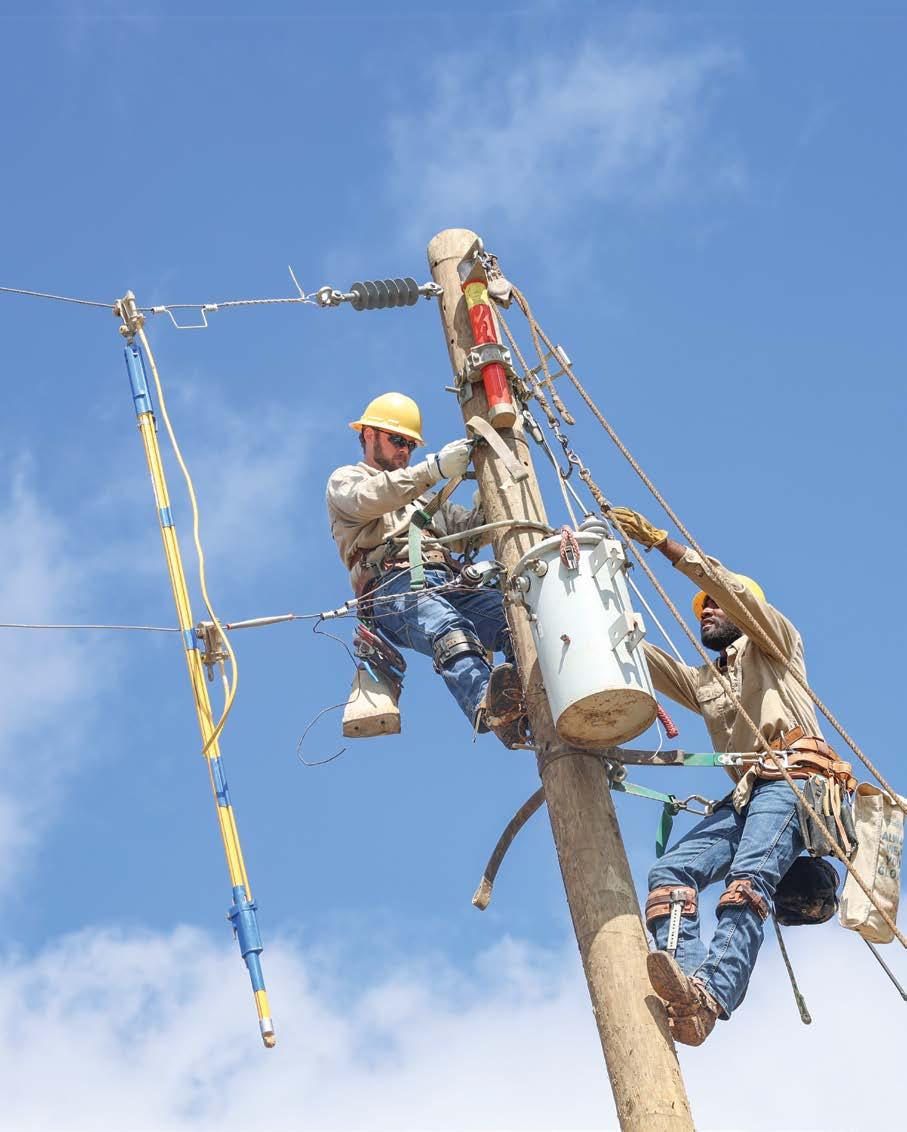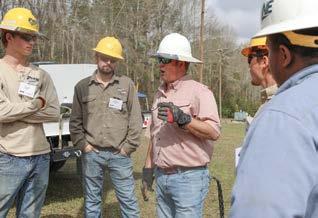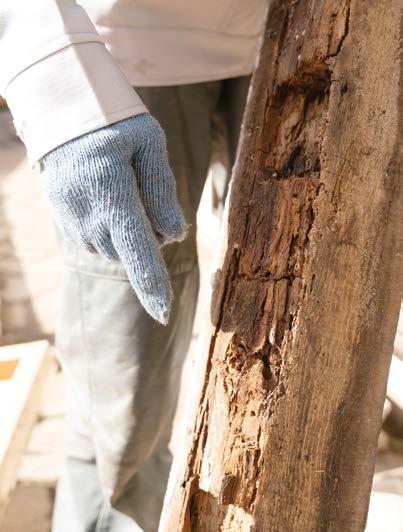






GRILLED CHEESE DREAMS






PICTURE THIS: COZY KIDS IN COATS

TRAVELS OF A BRAT PACKER











GRILLED CHEESE DREAMS






PICTURE THIS: COZY KIDS IN COATS

TRAVELS OF A BRAT PACKER



Part of our mission at Today in Mississippi is educating our members about the cooperative industry and how decisions made in Washington, D.C. a ect all of us back home.
We take our job of providing safe, a ordable, and reliable power very seriously.
Being reliable is near and dear to our reputation.
Reliability is the centerpiece of our argument for an electric grid our members can depend on to deliver power you can a ord.
We know members have concerns that the lights won’t stay on when our system is stressed.
When we look at how Washington is handling these situations, we don’t see a pretty picture. Regulations with arbitrary timelines. Technology mandates. A system increasingly out of balance: we have record electric peaks and growing electric demand, but we’re prematurely shutting down power plants. We can’t get permits to build new transmission. Bureaucrats want to breach dams and tear out baseload hydropower. And gas plants designed for peak demand are now running more and more hours every year.
We know that means higher energy costs for everyone and less firm supply, and less certainty we can get electricity when members need it.
Last fall, the people responsible for advising the U.S. government on electric reliability told us, for the first time ever, one of the biggest threats to a reliable electric grid, is bad public policy.
Bad legislation, poorly-thought-out regulation, faulty assumptions, and mandates put reliability at risk.
A great example of this flawed thinking is the power plant regulation proposed by the Environmental Protection Agency last year. I guarantee you they never thought about reliability. The EPA wants to shut down existing generation and mandate new technologies that aren’t ready for prime time.
What the EPA is asking us to do is to take a big step forward, but to do it in the dark. And this is not a time or a topic to rush. When we make these kinds of decisions, we need to know we’re on solid ground.
Things have gotten this way because the conversation about energy policy – the positions people are taking, and the decisions people are making – are disconnected from the consequences they can cause.
And we have to re-connect them.
Co-ops keep the lights on. Reliability is the most important thing to us. If legislators and regulators understand nothing more than that, then they will listen to us now, when it matters.
What’s happening in Washington a ects all of us. It a ects our businesses, and our communities.
Carbon capture and hydrogen fuel technologies aren’t ready enough or cheap enough to be commercial-scale environmental solutions. We’ve told the EPA not to mandate them in new rules on our industry.
But we also support that argument with real-world experience. Co-ops are global industry leaders in testing and demonstrating those very technologies. It’s not theoretical to us. We know what we’re talking about.
Leaders are listening to us.
We’re investing in innovation. When we get opportunities to move the ball – on broadband, on new technology, on storage, on demand response, and energy e ciency – electric cooperatives step up and deliver.
Our message to D.C.: if you let us do our job, we will. Don’t paint us, or regulate us, with one broad brush. Flexibility and local control are key to our success.
We’re the only ones with the political courage to ask this one tough question and answer it honestly. We’re the only ones sticking up for the people who pay the bills – you, our members. You expect us to perform this simple, but incredibly important job.
We’re the leading voice on electric reliability because cooperatives are reliable. We are trustworthy and dependable.
We serve our communities by listening to members and finding the best solutions –solutions that work – cooperatively.
It’s the best thing about who we are, what we do, and who we work for.
 by Michael Callahan
Executive Vice President/CEO Electric Cooperatives of Mississippi
by Michael Callahan
Executive Vice President/CEO Electric Cooperatives of Mississippi


I’ll stay here in good ole south Mississippi, where I can speak Southern English with a drawl. And my speed of life is reduced to a crawl.
Peas and cornbread, smoked hocks, and collard greens are all 5-star dining to me! I eat dinner in the middle of the day and supper about 6 at night — Southern style.
I’ve been and seen plenty of the “othern,” so I’ll keep on being very southern in Mississippi.
Pass the peas and cornbread, fried chicken, and okra please! by Gene Laythe, a resident of Richton, and a member of Pearl River Valley Electric
What’s Mississippi to you?
What do you treasure most about life in our state? Send your brief thoughts to Today in Mississippi, news@ecm.coop or mail to P.O. Box 3300, Ridgeland, MS 39158
Submit your beautiful digital photo of life in Mississippi to Today in Mississippi, news@ecm.coop



The Official Publication of the Electric Cooperatives of Mississippi
Vol. 77 No. 4
OFFICERS
Ron Barnes - President
Brian Hughey - First Vice President
Brian Long - Secretary/Treasurer
Michael Callahan - Executive Vice President/CEO
EDITORIAL STAFF
Lydia Walters - VP, Communications
Steven Ward - Editor
Chad Calcote - Creative Director
Kevin Wood - Graphic Designer
Alan Burnitt - Graphic Designer
Courtney Warren - Graphic Designer
Chris Alexander - Member Services Coordinator
Steve Temple - Social Media Director
Kendle Dean - Administrative Assistant
EDITORIAL OFFICE & ADVERTISING
601-605-8600
Acceptance of advertising by Today in Mississippi does not imply endorsement of the advertised product or services by the publisher or Mississippi’s electric power associations. Product satisfaction and delivery responsibility lie solely with the advertiser.
• National advertising representative: American MainStreet Publications, 800-626-1181
Circulation of this issue: 475,497
Non-member subscription price: $9.50 per year.
Today in Mississippi (ISSN 1052-2433) is published 12 times a year by Electric Cooperatives of Mississippi Inc., P.O. Box 3300, Ridgeland, MS 39158-3300, or 665 Highland Colony Parkway, Ridgeland, MS 39157. Phone 601-605-8600. Periodical postage paid at Ridgeland, MS, and additional o ce. The publisher (and/or its agent) reserves the right to refuse or edit all advertising. The magazine is published for members of subscribing co-ops. The magazine is a bene t of membership.
POSTMASTER: Send all UAA to CFS. (See DMM 507.1.5.2) NON-POSTAL AND MILITARY FACILITIES: send address corrections to: Today in Mississippi, P.O. Box 3300, Ridgeland, MS 39158-3300
www.facebook.com/TodayinMississippi
www.todayinmississippi.com

Gov. Tate Reeves and the Mississippi Development Authority (MDA) recently awarded the sixth round of Mississippi Site Development Program grants. Industrial properties in Hancock, Pearl River, and Scott counties were among the latest recipients. Together, sites within Cooperative Energy’s Members’ service territories received over $268,000 in state grant support.
The Hancock County Port and Harbor Commission was awarded $100,000 to two sites within the county. The Commission will clear and grub 10-acre sites at both the Stennis Technology Park and Port Bienville Industrial Park. Both industrial sites are served by Coast Electric.
MDA awarded $118,500 to Scott County for environmental due diligence studies at the Wooten Industrial Site. The funds will be matched locally to complete preliminary review of the developability of the 400+ acre property along Interstate 20 in Lake, Mississippi. The property has the potential to be a prime industrial site with interstate frontage and railroad access along the CPKC line. The site is served by Southern Pine Electric.
Pearl River County received $50,000 for development of the Pearl River County Technology Park. Funds will be used to construct an access road into the 30-acre business park. The technology park aims to recruit light industry, research and development, and other technology-based companies from neighboring Louisiana and surrounding areas. The technology park is served by Coast Electric.
In 2017, the state Legislature created the Mississippi Site Development Program to assist public or private non-profit economic development organizations or local governments with preparing site-ready locations to attract new industry and private capital investment to the state.
Properties within Cooperative Energy’s Members’ service territories have received more than $27 million in Mississippi Site Development Program grants since the program’s inception.
Deploying broadband where terrain is rugged and population sparse is something to celebrate, so it’s no wonder electric cooperatives are marking connection milestones with subscribers and their hardworking sta s in fun and creative ways.
Coast Connect, based in Kiln, celebrates milestones on a regular basis. The broadband subsidiary of Coast Electric gifts Roku Ultra streaming devices via random drawings when new service areas open.
Subscriber No. 5,000 received a basket of co-op goodies and an Amazon Echo smart home device. At milestone 10,000, CoastConnect gave away a smart TV, a streaming service gift card and swag to one lucky subscriber. The co-op is closing in on 20,000 subscribers.
“Our team has been working tirelessly to bring fast, reliable phone and internet service to rural areas of South Mississippi, and we are excited to celebrate each milestone that brings us closer to our goal,” said Ron Barnes, co-op president and CEO of Coast Electric.
Coast Connect is not the only co-op in the state gifting goodies to subscribers when they hit fiber milestones. NT Spark, PearlComm Fiber, Singing River Connect, DE Fastlink, D.E. Lightspeed, M-Pulse Fiber, NE SPARC, FASTnet, East Mississippi Connect, Northcentral Connect, and TEPAconnect all mark the same milestones.














If you wonder what plants can be used in shaded areas of your landscape, I suggest that hardy and low-maintenance ferns are a great choice for adding lush, green foliage.
Ferns come in a variety of sizes, textures, and colors that can add visual interest to darker areas of the landscape. While we can grow lots of ferns in hanging baskets and pots, picking the ones to plant in the ground is a bit trickier.
Let’s explore some cool ferns that do well planted in the ground and are perfect for adding a touch of magic to your shade garden.
Imagine a fern that’s both bold and beautiful, and you’ve got the Autumn fern. It’s not very tall and has frilly leaves. The best part? The leaves start o a green-copper color and then turn a deep, lush green as the seasons change.
The Autumn fern is a reliable friend for your shade garden, always looking good and providing a pop of color.
It is a deciduous fern that typically grows up to 2 feet tall and wide, preferring partial to full shade and well-drained soil. It is deer-resistant and drought-tolerant, making it a great choice for many di erent types of garden settings.
If you’re into evergreen ferns, the Japanese Holly fern is a winner.
I love this fern because its dark green fronds are shiny and look a bit like holly leaves. Fronds are pinnately lobed, which means lobes are arranged on either side of a central axis, and their sharp, serrated edges give the plant a spiky texture.













This fancy fern is a favorite for folks who like their gardens to look good all the time.
Japanese Holly fern typically grows up to 2 feet tall and wide, preferring partial to full shade and well-drained soil rich in organic matter. It tolerates a wide range of soil types but does best in slightly acidic soil with a pH between 5.5 and 6.5. It is relatively easy to care for and a great addition to shady gardens or landscapes.
If you are looking for a native plant, the Southern Wood fern is a great selection.
These plants are bright green with leaves that appear lacy and sit on woody stems. The little leaf parts are paired up along the stem and have a fancy, serrated edge. As you move up the stem, the leaves get smaller, creating a cool pattern.
The Southern Wood fern is a natural decoration that adds texture and interest to shady areas.
So, if you’re thinking about creating a charming shady space, consider the Autumn, Japanese Holly, and Southern Wood ferns. They each will bring their own style to your garden, adding di erent colors, textures, and shapes.
Watch your shade garden turn into a beautiful and timeless place filled with nature’s green beauty.
 by Dr. Eddie Smith
by Dr. Eddie Smith


If you’re thinking about creating a charming shady space, consider the Autumn, Japanese Holly, and Southern Wood ferns. They each will bring their own style to your garden, adding di erent colors, textures, and shapes.















Not everyone can or desires to play team sports like football or basketball. Those who do usually only play for a short time. Few people get athletic scholarships to universities and fewer become pros.
However, anybody with reasonable arm and back strength can shoot a bow and enjoy archery for the rest of their lives. Just like in other sports, students involved in the Archery In Mississippi Schools program represent their schools in competitive events. Some earn scholarships to shoot for university teams.
“The AIMS program does really great for kids who can’t or don’t want to play traditional sports,” Dennis Adams, owner and head coach of the Mississippi Archery Academy in Pearl, said. “In Mississippi, archery is one of the fastest growing sports. In 2023, about 16,000 Mississippi students participated in state archery events.”



Under the aegis of the Mississippi Department of Wildlife, Fisheries & Parks, AIMS (www.mdwfp.com/aims/) introduces students from 4th to 12th grade to archery. More than 500 Mississippi schools participate. Most schools give participating students physical education credits.
We o er introductory archery lessons for free. A good beginner lesson is always essential for people trying to get into archery so they understand the physical and mechanical basics of how a bow operates and how to shoot it correctly.
To get into archery, Adams recommends getting a Genesis compound bow, the same type used by many schools in the AIMS program. A beginner bow costs about $150 to $200. Add a few arrows and a quiver to hold them, archers can begin shooting for about $300. Then, take a few lessons from an experienced archer.
“We o er introductory archery lessons for free,” Adams said. “A good beginner lesson is always essential for people trying to get into archery, so they understand the physical and mechanical basics of how a bow operates and how to shoot it correctly. We take children as young as 6 or 7 years old. We also have retired people in their 60s who want something fun to do shooting with us.”

Once they make their initial investment in equipment, archers can shoot all they want almost anywhere for nothing. Most people can’t fire high-powered firearms in their backyards. Archers can shoot in their backyards without disturbing or terrifying their neighbors. People can also shoot indoors in large buildings. Just make sure to use a good backstop to stop wayward arrows.
Shooting targets alone in the backyard could get monotonous even for the most ardent archers. Therefore, many archers enjoy entering tournaments. In many tournaments, archers shoot at life-size three-dimensional targets representing deer, hogs, or other game. Clubs throughout Mississippi periodically hold 3-D events where archers at various skill levels can compete. In some tournaments, top archers advance to higher levels of state, regional, or even national competition.
“From February through late summer, there’s usually a 3-D archery shoot somewhere in Mississippi just about every weekend,” Adams said. “Not only fun, these events sharpen skills for people who want to hunt with a bow because they shoot at targets in stimulated hunting situations.”

People interested in archery might want to join a local club or the Archery Shooters Association — asaarchery.com. For information on the Mississippi Archery Academy, visit mississippiarcheryacademy.com or call 601-500-2670.
 by John N. Felsher
by John N. Felsher
John N. Felsher is a professional freelance writer, broadcaster, photographer, and editor who lives in Alabama. An avid sportsman, he’s written more than 3,300 articles for more than 170 different magazines on a wide variety of outdoors topics. Contact him at j.felsher@hotmail.com.













 by Steven Ward
by Steven Ward
Fans of actor Andrew McCarthy, best known for his roles in 1980s films “Pretty in Pink” and “St. Elmo’s Fire,” might have noticed a Facebook post he published about Mississippi last December.
The post, dated Dec. 14, 2023, started out with the sentence — “One of the happiest surprises of my travel life has been Mississippi.” The post included photos McCarthy took of Elvis Presley’s home in Tupelo, a cotton field in the Delta, Rowan Oak in Oxford, and a photo inside of Red’s Lounge, the Clarksdale juke joint. The post ended with the sentence, “Complicated” is a word you hear throughout Mississippi — I’m glad I came and can’t wait to return and dig deeper.”
The post garnered more than 1,000 comments — many from Mississippians — praising the actor for the visit.
McCarthy, who these days is a travel writer who has penned two travel memoirs and a third memoir about his days as one of the “Brat Pack” actors in the 1980s, was in Mississippi last December working on his latest book.
“I’m on a cross country journey exploring male friendship. It’s the third in a loose trilogy of what I call, personal travel books,” McCarthy told Today in Mississippi.
McCarthy said his enthusiasm about the visit was reflected in the comments his Facebook post received.
“Social media is funny. Despite people presenting their best “social” life we want the world to see, when you post something that has truth in it, people tend to respond. I had an amazing experience in Mississippi, and I guess that showed,” he said.

McCarthy, a lifelong fan of Presley, said he drove to Tupelo to see his birthplace. Although he had been to Graceland twice, he had never been to Presley’s hometown.
“I have to say I preferred the simplicity of the birthplace. People’s origin stories are always fascinating. I went to all the Elvis pilgrimage spots, the Tupelo Hardware Co., and I sat in the Elvis booth at Johnny’s BBQ,” McCarthy said.
McCarthy had never been to a gun show and went to his first while he was in Tupelo. He said he found the gun show “fascinating” and loved just wandering around Tupelo.
He went to Oxford and found it “elegant and welcoming.” He said he enjoyed his visit to Rowan Oak, the home of author William Faulkner.
McCarthy said he wanted to visit Money while he was in the state as well.
“I was very interested to drive down to Money, to the ruin of Bryant’s Grocery and Meat Market, where the Emmitt Till tragedy began. That the site has been left to decay, I found it the most powerful and disturbing ‘historical site’ I’ve ever visited,” he said.
McCarthy also visited Clarksdale, Vicksburg, and Natchez.
“I traveled on back roads throughout the state, never on the interstates — a way of traveling I would recommend,” McCarthy said.
Besides the current travel book McCarthy is working on about male friendship, McCarthy has directed a documentary about his

time as an actor in 1980s — an o shoot of his 2021 memoir, “Brat: An 80s Story.” The documentary, “Brats,” will premiere on Hulu later this year. In it, McCarthy visits with fellow “Brat Pack” actors Emilio Estevez, Demi Moore, Rob Lowe, and Ally Sheedy.
“I wrote about that time in my life in a memoir because it was a seminal moment in my life; it altered the trajectory of who I would become, and I had never looked under that rock; quite the opposite, I had run from it for decades. So, it was worth a look. The film grew out of that, I now knew what I felt about that time, but what did the others feel? It was life changing and career altering for all of us, and I was curious. I hadn’t seen most of the old gang in 30 plus years. I was surprised. I think we all were by how much a ection we all had for each other after all this time. It was very satisfying,” McCarthy said.
Going back to his Mississippi trip, McCarthy said his best advice for people who think they know Mississippi, but have never been, is to see it for themselves.
“I would say what I say to anyone about travel anywhere, ‘Go see it for yourself.’ That said, Mississippi was one of the great surprises in my travel life. But if I’d thought about it, I shouldn’t have been surprised. “Complicated” was a word I heard a lot to describe Mississippi, and complicated places are invariably the most alive and interesting. I can’t wait to return.”














Send us photos of your favorite homegrown flowers.
Let us know what kind of flowers are in the photo. The photos must be high-resolution JPG files of at least 1 MB in size. Please attach the photo to your email and send it to news@ecm.coop. Each entry must be accompanied by photographer’s name, address, and co-op.



SUBMISSION DEADLINE: May 31. Select photos will appear in the July 2024 issue.
If you're tired of having knee pain and want to talk to a doctor that can virtually give you your life back if knee pain is an issue, call Dr. Rob Acord... as he's the only doctor in the area... who has this newly discovered knee pain reduction technology.
If you have knee pain, can't walk because of an old injury, or you just think it's part of getting old, you might want to read this article.
Knee pain is something that disables a lot of people every single year, but most people don't know what to do about it.
Some people immediately opt in for surgery, then some people watch TV and end up buying something they wrap their knee with-hoping it will help, and others just follow orders and take medications which simply block the pain signals while the underlying condition often progresses.
All I'm saying is this. There are a lot of ways to TREAT your knee pain, but which one will really work?
If you've done your research, you know that there are not a lot of things that really work when it comes to actually helping align the knee, taking nerve pressure off the knee, and reducing the pain and swelling. What if there was a "real solution" that worked from DAY ONE?
Hi, I'm Dr. Rob Acord and I'm here to tell you about a new device called the K.P.R.
I stumbled onto this one-of-a-kind machine at a recent medical conference and tried it myself.
THE RESULTS: My knees have never felt so good, and that was after.... just one treatment.
It virtually reduced my knee stiffness by 95%, so I am positive it'll help your knee pain, help you walk better as soon as you get your first treatment, plus help you do some things you used to do without the help of a walker, cane, or someone else helping you

Now, don't get me wrong. I'm not guaranteeing a miracle if you haven't walked in many years.... but this just may be the answer you've been looking for.
Better late than never for sure. You should entertain this option... no matter what's happened to you in the past!
Let me be very clear; I'm here to possibly help you:
Get out of pain Walk better Move better
Get up and down better Get out of chairs easier AND...
Finally you will be able to move without relying on someone or something else
Here's all I can tell you If you’re bone on bone, and surgery is not an option for you, or surgery didn’t work, this may be the exact treatment you’ve been needing
You'll find out that K P R is an amazing machine when teamed up with our Class IV laser therapy
Great questions and here's the answer: We have a reputation for getting great results, but if you're like most of our patients you know that the knee problem isn't going to just go away on its own. We're also known for our personalized care We don't promise the world, but we will do everything humanly possible to get the results you want.
"I've NEVER done this before!" I'm going to offer you a consultation, knee examination, X-Rays, and TRIAL VISIT for only
$47 $47
We'll know almost IMMEDIATELY if we can help and most importantly, YOU WILL TOO
As you know, it's human nature to procrastinate; this is not the time to do that... WHY?
My Trial Offer goes away at the end of this month It's available as a hard deadline because I have a limited number of trial spots and we are already an extremely busy office. Pick up the phone and call the office now This one call could change the way you walk, feel, and move CALL TODAY!







































You probably don’t think about them until your power goes out, but electric lineworkers protect our homes and communities 24 hours a day. Like other first responders who keep us safe, lineworkers endure all kinds of weather and challenging conditions. In April, we celebrate Lineworker Appreciation Month to honor the men and women who power life. Here are some quick facts about lineworkers and the work they do.
Lineworkers first appeared during the 1840s rush to spread telegraph service across the U.S., stringing wires between trees and other natural objects. It didn’t take long for everyone to realize tall poles were safer and more practical.
Restoring electricity after a power outage is just one of the many duties of lineworkers, who also:
• Install and connect new power lines to homes and businesses
• Maintain and perform upgrades to improve our electric grid
• Diagnose and pinpoint power delivery issues
• Plan and manage large-scale projects
• Ensure safe work practices in often challenging conditions Lineworkers are responsible for maintaining and upgrading the nation’s electric grid that connects more than 7,300 power plants to 145 million consumers through 60,000 miles of high-voltage lines, millions of miles of distribution lines and more than 50 million transformers.
Lineworkers climb with up to 40 pounds of safety gear and tools. That’s like carrying a 5-gallon water jug! Here’s what they typically wear to stay safe while working:
• Hard hats
• Safety glasses
• Flame-resistant clothing
• Arc flash protective clothes
• Rubber gloves & sleeves
• Climbing belts
• Fall-protection harnesses
One essential tool for lineworkers is the hot stick, an insulated fiberglass pole used to safely move energized wires and other equipment. Hot sticks vary in size depending on the job.

Squirrels and snakes are a major cause of power outages, and lineworkers encounter plenty of both while working. They’ve also been known to rescue kittens that climbed too high in a tree and curious bears on top of utility poles. When your o ce is the great outdoors, these encounters are part of the job.
Described by the Energy Department as one of the nation’s highestpaid professions that doesn’t demand postsecondary education, becoming a journeyman lineworker typically requires a high school diploma or equivalent, training and a paid apprenticeship, which typically spans four years. Apprentice lineworkers receive hands-on training and experience in the field before advancing to “journeyman” status. Lineworker salaries range from $40,000 to $144,000, depending on location, skillset and experience.
Roughly 60,000 lineworkers hit the road annually to respond to devastating storms and the damage they leave behind. In addition to extreme weather exposure, lineworkers face a variety of dangers, including electric shock, falls from elevated work locations and roadside tra c accidents. High injury rates among early lineworkers led to the creation of apprenticeship programs and organized labor throughout the industry.
Safety is always the number one priority, which is why lineworkers continuously receive training to stay mindful of safety requirements and up to date on the latest equipment and procedures.
Lineworkers power our lives. The next time you see one, remember to thank them for the essential work they do.








A group of 85 high school juniors from all over the state gathered in Jackson from Feb. 21 to Feb. 23 for the 37th Electric Cooperatives of Mississippi Cooperative Leaders Workshop.
The program instills leadership skills, inspires creative thinking, encourages community service, and introduces students to legislative elected o cials from their communities.
The conference was held at The Westin in downtown Jackson.
The students earned the trip to the workshop following a competitive selection process sponsored by their local electric cooperative. They will travel to Washington, D.C. in June for a seven-day youth leadership tour.



Twin County students Claire Siebert, Hannah Kate Hooker, and Walker Winter spent the three days in Jackson with other students from around the state. They met with their state lawmakers, toured the state capitol, participated in problem solving activities, and attended speeches by motivational speakers — including one by political cartoonist Marshall Ramsey — who urged them to serve their communities.
Lt. Gov. Delbert Hosemann and Secretary of State Michael Watson spoke to the students during the workshop.















Change is a constant in today’s energy industry. And electric co-ops across the country are leaning into change as we explore new ways to meet tomorrow’s growing energy needs.
Electric co-ops play a crucial role in ensuring the lights come on every time Americans flip the switch. Our primary responsibility is to our members, and we remain committed to providing service that is both reliable and affordable. Energy policy has a profound impact on our ability to accomplish those goals and our national energy policies must embrace this fundamental promise.
The North American Electric Reliability Corporation (NERC), the watchdog for our nation’s grid, has issued several warnings about threats to grid reliability, warning that rolling blackouts could soon be the new norm. Nine states experienced blackouts in 2022 when electricity supply simply could not keep up with demand. And over the next five years, NERC forecasts that all or parts of 19 states from Montana to Louisiana are at high risk of rolling blackouts during normal peak conditions.
These warnings should not be taken lightly, which is why electric co-ops are pressing policymakers to recognize the need for time, technology development and new infrastructure, alongside policies that include a diverse mix of energy sources to maintain reliable power.
The economy of the future will be heavily reliant on electricity. From data centers and manufacturing to electric vehicles and electric heat pumps, the demand for electricity is set to rise dramatically. Co-ops are planning for this surge in demand by investing in infrastructure, technologies, and power supplies that will allow them to meet members’ needs, but additional challenges lie ahead.
Opposite this increasing demand for electricity, many power plants that generate always available electricity are being shut down without adequate replacements, posing a significant threat to reliability. The Environmental Protection Agency (EPA) is pursuing sweeping new regulations that would force the premature closure of always available power plants while also making it harder to permit, site, and build critical new plants. Electric co-ops have urged the EPA to withdraw these proposed regulations that would lead to more blackouts, higher costs, and uncertainty for Americans.
Electric co-ops are at the forefront of innovation and are already adapting to the unique needs of the members we serve. From community solar projects and energy efficiency programs to carbon capture and advanced nuclear generation, co-ops are leading the way.
Advocating for rational policies in Washington, D.C. that preserve reliability and affordability is crucial. This month, electric cooperative leaders will gather in Washington, D.C., for the annual Legislative Conference where they will meet with members of Congress and federal agencies to discuss key issues and concerns surrounding reliability. This allows co-ops to educate policymakers on the issues that matter most to the American families and businesses we serve.
Today’s energy decisions and policies will determine if there are enough resources to meet tomorrow’s energy needs. Electric co-ops will continue advocating for their members to ensure a reliable supply of electricity that powers everyday life.
Louis Finkel is the senior vice president of government relations for the National Rural Electric Cooperative Association.











1-844-AGENT4U
Serving Miss-Lou STATEWIDE Since 1992
Culotta Insurance & Investments
Culotta Insurance & Investments
Culotta Insurance & Investments
Culotta Insurance & Investments
FIXED INDEXED ANNUITIES
Serving Miss-Lou STATEWIDE Since 1992
1-844-AGENT4U
Serving Miss-Lou STATEWIDE Since 1992
Serving Miss-Lou STATEWIDE Since 1992

Serving Miss-Lou STATEWIDE Since 1992
MORE GAINS • NO LOSSES • SAFETY
1-844-AGENT4U
1-844-AGENT4U
1-844-AGENT4U
1-844-AGENT4U
1-844-AGENT4U

Up to 11% IMMEDIATE
FIXED INDEXED ANNUITIES
FIXED INDEXED ANNUITIES
FIXED INDEXED ANNUITIES
FIXED INDEXED ANNUITIES MORE GAINS • NO LOSSES • SAFETY
FIXED INDEXED ANNUITIES
MORE GAINS • NO LOSSES • SAFETY
1-844-AGENT4U
FIXED INDEXED ANNUITIES
FIXED INDEXED ANNUITIES
MORE GAINS • NO LOSSES • SAFETY
Up to 11% IMMEDIATE INTEREST BONUS on DEPOSITS
MORE GAINS • NO LOSSES • SAFETY
MORE GAINS • NO LOSSES • SAFETY
MORE GAINS • NO LOSSES • SAFETY
Up to 11% IMMEDIATE INTEREST BONUS on DEPOSITS
Up to 11% IMMEDIATE INTEREST BONUS on DEPOSITS
Up to 11% IMMEDIATE INTEREST BONUS on DEPOSITS
Up to 12% IMMEDIATE INTEREST BONUS on DEPOSITS ROLLOVER CD OR 401K TODAY!
Up to 11% IMMEDIATE INTEREST BONUS on DEPOSITS
ROLLOVER CD OR 401K TODAY!
Up to 11% IMMEDIATE INTEREST BONUS on DEPOSITS
ROLLOVER CD OR 401K TODAY!
ROLLOVER CD OR 401K TODAY!
ROLLOVER CD OR 401K TODAY! FINANCIAL FREEDOM

MORE GAINS • NO LOSSES • SAFETY
Up to 11% IMMEDIATE INTEREST BONUS on DEPOSITS
FINANCIAL FREEDOM
ROLLOVER CD OR 401K TODAY!
ROLLOVER CD OR 401K TODAY!
ROLLOVER CD OR 401K TODAY!
Proud Partner New Orleans Pelicans
FINANCIAL FREEDOM
FINANCIAL FREEDOM
Proud Partner of the New Orleans Pelicans
FINANCIAL FREEDOM
Proud
SAFE RETIREMENT STRATEGIES, MEDICARE SUPPS, LONG-TERM CARE, MEDICAL & LIFE
Proud Partner of the New Orleans Pelicans
Proud Partner of the New Orleans Pelicans
Proud Partner of the New Orleans Pelicans





































Linework is one of the most dangerous jobs on the planet.
“We use the word hazardous,” said Chad Crockett, director of education and apprenticeship training for the Electric Cooperatives of Mississippi.
Crockett made the comment while sitting with a group of apprentice linemen from electric co-ops all around the state at a recent week-long training session at Dixie Electric in Laurel.
The training — ALTS 1 school or Apprentice Lineman Training School 1 — was focused on cooperative linemen that have two or less years of experience. The session had 53 linemen and eight instructors. The focus of the school was framing poles and doing basic design for repair work under “non-energized” environments. A first-year apprentice is strictly prohibited from working on energized conductors or poles with energized lines.
One of the eight stations at the school tested linemen on skills needed for poll top rescue. The station is notable for the one spot at the school with a raggedy and muddy, yet sturdy dummy lineman hanging from a bucket truck. The dummy weighs about 180 pounds.
The catastrophic nature of an injury or accident that is associated with a high voltage electrical contact. Damage to person and property is almost always totally destructive.
Although the environment is “non-energized,” it was still apparent that linemen are a special breed.

The idea behind the task is ensuring a lineman can get up a pole, rescue, and pull down an unconscious lineman before he succumbs to his injuries.
Josh Geiger, an instructor with the Electric Cooperatives of Mississippi’s safety department, told the linemen at his station that the serious damage occurs to an unconscious lineman after about 4 minutes.
After a briefing, the linemen at the station took turns climbing the pole to safely get the dummy back down as Geiger scored them from a nearby bucket.
Welcome to Lineman Apprentice Training School.






Gerald Gordon, vice president of the Electric Cooperatives of Mississippi’s department of safety and loss control, said “the most dangerous job” designation stems from two facts.
“The catastrophic nature of an injury or accident that is associated with a high voltage electrical contact. Damage to person and property is almost always totally destructive,” Gordon said. “Also, the frequency with which a lineman handles high voltage carrying conductors in the daily charge of the job. Most jobs can categorize functions in various degrees of risk and then adjust their level of safety awareness to match said risk. A lineman’s job is to deal with a 10/10 risk daily.”
So how does one become an electric cooperative lineman in Mississippi?
“The typical lineman will apply for a job at one of our systems after completing lineman school. This is often referred to as ‘climbing school.’ That training usually takes around 16 weeks to complete and is done through one of the lineman schools administrated by a Mississippi community college. There are written exams as well as physical proficiencies that must be demonstrated in order to graduate with a certificate of training,” Gordon said.
Gordon said there’s one trait above others that linemen need to possess to be successful.
“Toughness. It is most productive when coupled with a healthy fear/respect for the dangers of the job, but the best linemen I know are just tough.”


I saw linemen out working. Being outside was attractive. I’m an outdoors person. Also, I love heights.






Lineman school instructor Scott Weeks, a 30-year veteran of the state’s electric cooperatives and manager of safety at Magnolia Electric, said the linemen at Laurel were one of the youngest groups he’s ever seen come through.
“We are talking 20 and 21-year-olds, some with only 3 to 4 months of line work behind them,” Weeks said.
Hunter Adams, 22, has been a lineman with Singing River Electric for a little over a year.
“I knew I wanted to be a lineman from family and friends in the industry. I like working with my hands, being outside, and doing something di erent every day,” Adams said.
Adams said he has a firm understanding of the hazards of the job.
“As long as you do everything right and follow standard operating procedure, everything is fine.”
Trontavius Townes, 22, has been a lineman for Tallahatchie Valley Electric for a year and a half.
Townes was 16 when he first realized he wanted to be a lineman.
“I saw linemen out working. Being outside was attractive. I’m an outdoors person. Also, I love heights,” Townes said.
Gordon said the “on call” aspect of the job is tough.
“Even if you are not one of the designated linemen that is technically on call on a given night or weekend, you know that the weather could make it an ‘all hands-on deck’ situation. Second to that would be the stress of the work. The combination of working very long hours in such a high-risk environment,” Gordon said.
So, what motivates linemen getting into the profession?



“Pride. I do not know of a single lineman that would give you an answer that doesn’t include that word. The pride of being able to look back at the end of the day and see the spans of line that have been constructed. Or to see the complicated pole structure that was taken down by a car accident but is now back in the air, even better than before, and the service has been restored,” Gordon said.
A lineman’s pride also kicks in during times of mutual aid — helping other electric cooperatives during a time of crisis or disaster.
“Communities that have been days or weeks without power and have gotten into, sometimes, some really desperate situations due to lack of electricity, but then the linemen roll in. Families frequently come out to the trucks and gather dirty clothes to go wash and bring back at the end of the day. They bring food and water to the men. Pretty much every time a system goes to help with hurricane restoration, entire classrooms of children will send thank you cards and write stories about how thankful they are for people they have never met that came from multiple states away to help them in their time of need.”








I knew I wanted to be a lineman from family and friends in the industry. I like working with my hands, being outside, and doing something di erent every day.









House and building owners must be on high alert each spring as structures face dangerous attacks by swarms of both native and introduced termite species.
Native, subterranean termite species started swarming in late February in South Mississippi to early March in more northern areas. The non-native, invasive and very damaging Formosan subterranean termite begins swarming in some parts of Mississippi in May.
Santos Portugal, Mississippi State University Extension Service urban entomologist, said the native subterranean termites in their natural environment are a good thing as they help to break down dead trees and release nutrients back into the soil.
“But termites in structures are a bad thing, especially since we tend to make our buildings out of their favorite type of food — dead trees,” Portugal said.
Swarming is when hundreds to thousands of termites in their reproductive, winged stage go on mating flights from established colonies.
“They will pair o , mate, detach their wings and look to establish a new colony,” Portugal said. “In Mississippi, the eastern subterranean termite and related species tend to swarm anywhere from mid-February to mid-May depending on where you are in the state.
“These termites are native, abundant and can be found in any county in Mississippi,” he said. “They swarm during daytime hours, as opposed to the invasive Formosan subterranean termite that swarms at night and emerges later in the season.”
Eastern subterranean termites are about 3/8 of an inch long including their two long, equal-sized pairs of light-colored wings. Their bodies are often black or dark brown.

“If you find swarmers outdoors near your house, you might consider reaching out to a qualified pest management company to have an inspection conducted on your home,” Portugal said. “If you find swarmers indoors, it is very likely that you have an infestation and should reach out to a qualified pest management company to request an inspection and bid for treatment.”
Professionals recommend that due to the high level of termite activity in Mississippi, all building owners should have a current termite contract on their structures. Seeing swarmers anywhere in the landscape is a reminder to ensure the contract is current, and the building has been treated.
Blake Layton, MSU Extension entomologist, said all buildings in the state should be preventatively treated for termites. Be sure not to disturb treatments once they have been applied or installed.
“Buildings that are not properly protected from termites will eventually be damaged by termites,” Layton said. “Termite control is not a do-it-yourself job. If you want the job done right, it is important to contract with a licensed pest control company to apply termite treatments.”
Layton said termites occur in all home landscapes and will readily invade buildings if given a chance.



“In the pest control industry, situations that give termites a greater chance to invade buildings are referred to as conducive conditions,” he said. “Mulch piled too high against exterior foundations, direct wood to soil contact, firewood or lumber stacked against the building and moisture problems due to structural or plumbing leaks are just a few examples of conducive conditions.”



Buildings that are not properly protected from termites will eventually be damaged by termites. Termite control is not a do-ityourself job. If you want the job done right, it is important to contract with a licensed pest control company to apply termite treatments.






























Before grilled cheese captivated childhoods, there was the cheese dream. The cheese dream was an open-faced grilled cheese sandwich popular in the U.S. during the Great Depression. In the 1920s, sliced bread and American cheese were inexpensive and readily available. Eventually, people started to close the sandwich with a second piece of bread to make the meal heartier. The term “grilled cheese” appeared in the 1960s and has been an American staple ever since.
Made with everyday ingredients, bread, butter, and cheese, and heated, the classic grilled cheese foundation has remained unchanged over six decades. Nothing beats a classic grilled cheese by itself or with a side of chips or a cup of soup. But if you want to elevate your childhood ooey-gooey favorite, you can easily do so by being intentional with the bread, cheese, and filling choices.
Made with everyday ingredients, bread, butter, and cheese, and heated, the classic grilled cheese foundation has remained unchanged over six decades. Nothing beats a classic grilled cheese by itself or with a side of chips or a cup of soup.
Choose fresh sourdough bread because of its flu y texture and slightly tangy flavor. Sourdough crips well while staying soft on the inside and pairs well with a variety of cheeses. French bread and Ciabatta also have a crunchy exterior, while multigrain, pumpernickel, and Texas Toast add texture and flavor.
Look past the pre-packaged sliced cheese and head to the deli. Ask for American, Sharp, Monterey Jack, or Pepper Jack cheese, sliced for sandwiches. Deli-sliced cheese is rich in calcium, protein, and flavor and melts better. Go untraditional and try Gouda, Fontina, Gruyere, or a brie. Try sharp Cheddar, Monterey Jack, and Gouda together for a delicious trio. Take the cheese out of the refrigerator and let it come to room temperature before cooking; this will help the cheese melt faster. You can stop there and proceed to the perfect grilled cheese. But if you want to try something new, add sauteed spinach or fresh arugula, caramelized onions, chopped steamed vegetables, roasted peppers, tomatoes, or bacon. Go gourmet and mix Gruyere and brie cheese with thinly sliced apples and a smear of jam.
A cast iron griddle or skillet is best for heat distribution, but regardless of the pan, go low and slow. You can turn up the heat by switching from butter to mayonnaise as your fat choice. Butter burns quickly, while mayonnaise has a higher smoke point. Mayo allows you to turn up the heat without burning and achieve a golden exterior with a hot and gooey middle. And, of course, remember a pickle on the side!

4 tablespoons unsalted butter, room temperature
8 slices sourdough bread
4 slices sharp cheddar cheese, about 4 ounces total
8 slices thick cut Applewood smoked bacon, cooked (optional) 16 tomato slices
4 ounces arugula
4 slices Swiss cheese, about 4 ounces total
4 slices Monterey Jack cheese, about 4 ounces total

Place one slice of cheddar onto a piece of bread. Top with bacon (optional), tomato, and arugula. Add remaining cheese. Place a piece of bread on top. Butter the top slice of bread.
Warm a griddle or skillet over medium heat. Place butter side down. Butter slice of bread facing up.
Cook for 3-5 minutes or until golden brown. (You can put a heavy skillet on top to help press it down for the cheese to melt faster.)
Carefully flip the sandwich, and cook for 2-4 minutes on the second side.
Wipe out the pan with a paper towel and repeat until all sandwiches are cooked.



2 slices sourdough bread
1 tablespoon salted butter, softened
2-3 slices or about 2-3 oz of grated Fontina cheese
Warm a griddle or skillet over medium-low heat. You’ll want to warm the pan before you add your bread.
Butter both sides of each slice of sourdough bread.
Add your cheese to one piece of sourdough bread, then top with the other.
Place the sandwich in the warmed skillet and grill it on both sides until each is a nice golden brown color and the cheese is melted. Depending on the thickness of your cheese and sourdough slices, this may take 2-4 minutes per side.
Remove the grilled cheese from the pan and rest for a few minutes before slicing down the middle and serving.
 by Rebecca Turner
by Rebecca Turner
Rebecca Turner is an author, registered dietitian, radio host, television presenter, and board-certified in Lifestyle Medicine. She is A lifelong Mississippian and a member of the Central Electric Coop in Brandon. Her books, “Mind Over Fork,” and “Enjoy Good Health,” offer no-nonsense nutrition guidance that challenges how you think, not how you eat. Find her on social media @RebeccaTurnerTalks or online at RebeccaTurnerNutrition.com.
The Waynesboro Whistle Stop Arts and Crafts Festival. April 6. Waynesboro. From 10 a.m. to 4 p.m. This year’s theme is “Peace, Love & Whistle Stop.” This year’s downtown event includes pony rides, food, arts and crafts vendors, the Barney & Marie Memorial Car Show, children’s train rides, and other activities. Details: 601-735-2268 or email librarywayne39367@gmail.com.
Gulf States Quilting Association Biennial Quilt Show. April 12 and 13. Slidell, Louisiana. Harbor Center, Slidell, LA. Will be held at the Harbor Center. The four states in the Gulf States Quilting Association are Mississippi, Alabama, Louisiana, and the Florida panhandle. The event features around 300 quilts from the gulf states region on display in this judged event. The show will also have vendors, a member boutique, door prizes, scissor and knife sharpening, food trucks, and more. A gorgeous one-of-a-kind themed quilt, “Gulf States Beauty,” made by members and appraised at almost $3,000, will be ra ed. Hours are 10 a.m. to 5 p.m. each day. Admission is $12 and $5 for children under 12. Details: gulfstatesquilting.org or email gulfstatesquiltingassociation@gmail.com.
Barnyard Marketplace. April 13. Poplarville. The event will be held at 295 Buck Kirkland Rd from 9 a.m. to 2 p.m. Come shop the vendors in an open field. O street parking. Crafts, food trucks, woodwork, plants, jewelry, baked goods, boutiques, jams/jellies, honey, quail eggs, soaps, candles, and more. Customer giveaways. Spring garden tips. 4-H plant sale. Details: 504-234-3579.
Adams County Master Gardeners Plant Sale. April 13. Natchez. From 8 a.m. to noon. Co-Lin Natchez campus, 11 Co-Lin Circle. Featuring hanging baskets for $10 and potted plants for $5. Details: 601-445-8202.
Gulf Coast Military Collectors and Antique Arms Show. April 19 and 20. Biloxi. The event will be held at the Joppa Shriner’s Center, 13280 Shriner’s Blvd. April 19: 11 a.m. to 5 p.m. April 20: 9 a.m. to 4 p.m. Historical military artifacts from all periods and wars bought, sold, traded, and exhibited. Firearms, bayonets, daggers, uniforms, helmets, medals, insignia, patches, flags, and books are available. Details: 228-224-1120 or terrell.hamilton@gmail.com.
Pine Belt Quilters Showcase. April 20. Hattiesburg. Members will have an exhibit of quilts held at the Hattiesburg Cultural Center, 723 Main St. There will be demonstrations, door prizes, an opportunity to quilt, and more. From 10 a.m. to 4 p.m. Details: pbqnewsletter@ gmail.com or call 601-441-5637.
Star Spring Festival. May 4. Florence. Proceeds go to St. Jude Children’s Hospital. Event will be rain or shine. Vendors still needed. 5K and Kid’s Fun Run, Car, Truck, Tractor, and Bike Show, beauty pageant, silent auction, vendor/craft booths, 50/50 drawing, food, and DJ. 136 Moto X Dr. Details: 601-842-7947 or visit www. starspringfestival.com.
Springfest. May 4. Monticello. Put on by Divide Memorial M.P. Church, located 11 miles south of Monticello o Highway 27. From 8 a.m. to 3 p.m. Arts, crafts, entertainment, an auction, food, and free children’s activities. Details: 601-405-4975 or 601-431-9317.
62nd Mississippi Numismatic Association Coin and Currency Show. May 16, 17, and 18. Biloxi. Mississippi Coast Coliseum & Convention Center, Exhibit Hall 3, 2350 Beach Blvd. May 16: 10 a.m. to 6 p.m. May 17: 9 a.m. to 5 p.m. May 18: 9 a.m. to 3 p.m. Vendors from across the region will be buying and selling U.S. coins and currency, world coins and currency, and gold and silver bullion. Collecting supplies will be available for sale. Free admission and free verbal appraisals. Details: 228-435-8880.
The Hattiesburg Area Daylily Society’s Daylily Show. May 25. Hattiesburg. The event will be held at the Hattiesburg Train Depot from 1 p.m. to 4 p.m. The show includes a design division, judged by National Garden Club judges. A plant sale will begin at noon. Admission is free. Details: hattiesburgdaylily.com or call 601-466-3826.
The Hoppers 2024. June 14. Hattiesburg. Concert begins at 7 p.m. at Heritage Church, 3 Baracuda, Dr. Details 601-261-3371.









Anybody who grew up in Greenville when I did had to have been aware of William Alexander Percy. Most notably he was a writer and poet. The Greenville library is named for him. He penned “Lanterns on the Levee: Recollections of A Planters Son,” his autobiography. My third-grade teacher, Mrs. Alexander, pointed out that his poem “Overtones” was included in our English textbook.
William was the son of LeRoy Percy. In 1910, LeRoy Percy became the last senator appointed by the Mississippi Legislature. After that, the Seventeenth Amendment called for senators to be elected. In his race for re-election, Percy was defeated by James K. Vardaman who was backed by Theodore Bilbo. Back then I knew of LeRoy Percy because of the state park named for him, not for his politics.
The statue is a life-size figure of a man dressed in chainmail armor with a downturned sword in his folded hands. He sadly gazes past the sword as if he is remembering something from long ago.
I bring all of this up because of a post I ran across on Facebook the other day about the preparation for removal of the statue over LeRoy Percy’s grave in Greenville. This isn’t one of those protest statue removals that was so popular a few years ago. There are just two members of the Percy family left in Greenville, and they want the statue where it can be better cared for than in the city cemetery.
The statue is a life-size figure of a man dressed in chainmail armor with a downturned sword in his folded hands. He sadly gazes past the sword as if he is remembering something from long ago. There are lines from the poem “The Patriot” by Robert Browning on the back of the marble stone behind the statue. The poem speaks of the sacrifice of a misunderstood leader.
There was a ghost story associated with the statue that I heard when I was growing up in Greenville. The gist of it is the statue speaks under the right conditions. You must go there at midnight, which right away recuses me from any first-hand knowledge of what follows. I wasn’t about to go to a dark cemetery at midnight. But you walk up to the




statue and place your hands on top of his hands and look him straight in the eye. You ask him, “What are you doing here?” He is supposed to say, “Absolutely nothing.” Friends of mine who tried it tell me it’s true. And it’s not just an occasional response. The statue says absolutely nothing every time you ask it.
Well, no longer will the patriot reign over Greenville Cemetery. According to a post by my schoolmate Bill Beckwith — a renowned bronze sculptor who lives and works in Taylor — the statue is going to the Mississippi Museum of Art in Jackson. I hope it isn’t hidden away or put behind ropes. I’d like to occasionally look him in the eye and ask him what he’s up to. It’d be good to hear from someone from home now and again. Even if they have absolutely nothing to say.
 by Walt Grayson
by Walt Grayson
















